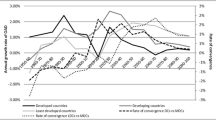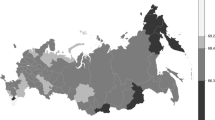Abstract
The issue of population ageing is no longer exclusively centred on developed countries. Empirical studies have proven that the rise in the proportion of the older age group has been already visible in the least developed countries (LDCs). The primary concern of population ageing in LDCs is that ageing is approaching LDCs even faster than approaching developing and developed countries. We found that despite the common factors such as human capital development, female participation in the labour market and economic growth, the annual growth rate of the ageing of LDCs highly depends on international aids (health care and development) and the rising number of emigrations over the working-age population. Our empirical results suggest that the existence of the ageing population in LDCs determine by the involvement of international bodies in supporting the welfare system of the country and the policy initiatives of developed countries in attracting migrant workers of LDCs to overcome the ageing problem in their countries.

Source Own computations based on data from UNDESA population division

Source Authors’ own design
Similar content being viewed by others
Notes
AI measured by the ratio between the old-age group (age above 60) and the young age group (age 0–14).
OAD measured by the ratio between the old-age group (age above 65) and the young working-age group (age 15–64).
References
Aguiar, M. (2011). Consumption versus expenditure. Journal of Political Economy, 113, 919–948.
Aguila, E., Attanasio, O., & Meghir, C. (2011). Changes in consumption at retirement: Evidence from panel data. The Review of Economics and Statistics, 93, 1094–1099.
Alders, P., & Broer, D. P. (2004). Ageing, fertility, and growth. Journal of Public Economics, 89, 1075–1095.
Angeles, L. (2010). Demographic transitions: Analyzing the effects of mortality on fertility. Journal of Population Economics, 23, 99–120.
Arellano, M., & Bond, S. (1991). Some tests of specification for panel data: Monte Carlo evidence and an application to employment equations. The Review of Economic Studies, 58, 277–297.
Arellano, M., & Bover, O. (1995). Another look at the instrumental variable estimation of error component models. Journal of Econometrics, 68, 29–51.
Becker, G. S., Edward, G. L., & Kevin, M. M. (1999). Population and economic growth. The American Economic Review, 89, 145–149.
Bendavid, E., & Bhattacharya, J. (2014). The relationship of health aid to population health improvements. JAMA Internal Medicine, 174, 881–887.
Bloom, D. E., Canning, D., & Fink, G. (2011). Implications of population aging for economic growth. NBER working paper series, 16705.
Bloom, D. E., & Williamson, G. J. (1998). Demographic transition and economic miracles in emerging Asia. The World Bank Economic Review, 12, 419–455.
Bond, S., Hoeffler, A., & Temple, J. (2001). GMM estimation of empirical growth models. C.E.P.R. discussion papers, no. 3048, University of Bristol, Bristol.
Börsch-Supan, A. (2013). Myths, scientific evidence and economic policy in an aging world. The Journal of the Economics of Ageing, 1–2, 3–15.
Blundell, R., & Bond, S. (1998). Initial conditions and moment restrictions in dynamic panel-data models. Journal of Econometrics, 87, 115–143.
Brea, J. A. (2003). Population dynamics in Latin America. Population Bulletin, 58, 1–36.
Brinker, G., & Amonker, R. (2013). Socioeconomic development and fertility trends among the states of India. International Journal of Sociology and Social Policy, 33, 229–245.
Choudhry, M. T., & Elhorst, J. P. (2010). Demographic transition and economic growth in China, India and Pakistan. Economic Systems, 34, 218–236.
Cutler, D., Deaton, A., & Lleras- Muney, A. (2006). The determinants of mortality. Journal of Economic Perspectives, 20, 97–120.
Daumerie, B., & Hardee, K. (2010). The effect of a very young age structure on Haiti—Case study. Population Action International Healthy Families and Healthy Planet. Retrieved March 9, 2014, from https://populationaction.org/reports/the-effects-of-a-very-young-age-structure-on-haiti-a-country-case-study/.
De la Croix, D., & Licandro, O. (2012). The child is father of the man: Implications for the demographic transition. The Economic Journal, 123, 236–261.
Department of Economic and Social Affairs, Population Division (DESA/PD). (2007). World population aging 2007. New York: United Nations Publication.
Department of Economic and Social Affairs, Population Division (DESA/PD). (2010). World population ageing 2009. New York: United Nation Publication.
Díaz-Giménez, J., & Díaz-Saavedra, J. (2009). Delaying retirement in Spain. Review of Economic Dynamics, 12, 147–167.
Elgin, C., & Tumen, S. (2010). Can sustained economic growth and declining population coexist? Barro-Becker children meet Lucas. Economic Modelling, 29, 1899–1908.
Fanti, L., Iannelli, M., & Manfredi, P. (2013). Neoclassical growth with endogenous age distribution. Poverty vs low-fertility traps as steady states of demographic transitions. Journal of Population Economics, 26, 1457–1484.
Fatas, A., & Mihov, I. (2006). The macroeconomic effects of fiscal rules in the US states. Journal of Public Economics, 90, 101–117.
Findlay, A. M., & Wahba, J. (2013). Migration and demographic change. Population, Space and Place, 19, 651–656.
Harper, S., & Leeson, G. (2009). Introducing the journal of population ageing. Journal Population Ageing, 1, 1–5.
Hashimoto, K., & Tabata, K. (2010). Population aging, health care, and growth. Journal of Population Economics, 23, 571–593.
Heyneman, S. P., & Lee, B. (2016). International organizations and the future of education assistance. International Journal of Educational Development, 48, 9–22.
Hodgson, D. (1988). Orthodoxy and revisionism in American demography. Population and Development Review, 4, 541–569.
Hoffman, M. (2011). Does higher income make you more altruistic? Evidence from the holocaust. The Review of Economics and Statistics, 93, 876–887.
Hondroyiannis, G., & Papapetrou, E. (2001). Demographic transition and economic growth: Empirical evidence from Greece. Journal of Population Economics, 15, 221–242.
Hurd, M. D., & Rohwedder, S. (2011). Trends in labor force participation: How much is due to changes in pensions? Journal Population Ageing, 4, 81–96.
International Migration Institute (IMI) and National Institute of Demographic and Economic Analysis (NIDEA). (2013). Global migration futures Pacific region: Drivers, processes and future scenarios of migration. International Migration Institute.
Krupp, D. B. (2012). Marital, reproductive, and educational behaviors covary with life expectancy. Archives of Sexual Behavior, 41, 1409–1414.
Lee, R. (2003). The demographic transition: Three centuries of fundamental change. Journal of Economic Perspectives, 17, 167–190.
Malmberg, B., Tamas, K., Bloom, D., Munz, R. & Canning, D. (2006). Global population ageing, migration and European external policies. Institutet för Framtidsstudier.
Mason, A., & Lee, R. (2011). Population aging and the generational economy: key findings. In R. Lee & A. Mason (Eds.), Population aging and generational economy project. A global perspective (pp. 3–31). Cheltenham: Edward Elgar.
Meier, V., & Werding, M. (2010). Ageing and the welfare state: Securing sustainability. Oxford Review of Economic Policy, 26, 655–673.
Murtin, F. (2013). Long-term determinants of the demographic transition, 1870–2000. The Review of Economics and Statistics, 95, 617–631.
Nagarajan, R., Teixeira, A. A. C., & Silva, S. T. (2017). An empirical analysis of the demographic trends in least developed countries. Ageing International, 42, 251–273.
Nagarajan, R., Wada, M., Fang, M. L., & Sixsmith, A. (2019). Defining organizational contributions to sustaining an ageing workforce: A bibliometric review. European Journal of Ageing. https://doi.org/10.1007/s10433-019-00499-w.
Nardi, M. D., French, E., & Jones, J. B. (2010). Why do the elderly save? The role of medical Expenses. Journal of Political Economy, 118, 39–75.
Neumann, U. (2013). Are my neighbours ageing yet? Local dimensions of demographic change in German cities. Journal of Population Ageing, 6, 189–209.
Ogawa, N., Mason, A., Chawla, A., Matsukura, R., & Tung, A. C. (2009). Declining fertility and the rising cost of children. Asian Population Studies, 5(3), 289–307.
Owoo, N. S., Agyei-Mensah, S., & Onuoha, E. (2014). The effect of neighbourhood mortality shocks on fertility. European Journal of Health Economics. https://doi.org/10.1007/s10198-014-0615-3.
Porter, M. (2010). Health, longevity, and the role of the family in China. Journal of Population Ageing, 3, 103–109.
Rahman, M. I., & Ali, A. M. (2009). Population aging and its implications in Bangladesh. Jahangirnagar Review Part II Social Science, 31, 245–268.
Rashid, A., & Intartaglia, M. (2017). Financial development—Does it lessen poverty? Journal of Economic Studies, 44, 69–86.
Riboud, M. (1985). An analysis of women's labor force participation in France: Cross-section estimates and time-series evidence. Journal of Labor Economics, 3, S177–S200.
Roodman, D. (2009). A note on the theme of too many instruments. Oxford Bulletin of Economics and Statistics, 71, 135–158.
Samuelson, A. P. (1958). An exact consumption-loan model of interest with or without the social contrivance of money. Journal of Political Economy, 66, 467–482.
Schou, P. (2006). Immigration, integration and fiscal sustainability. Journal of Population Economy, 19, 671–689.
Sinding, S. W. (2002). The role of international funding in future fertility declines among intermediate-fertility countries. Population Bulletin of the United Nations: United Nations Publication.
Solomon Islands National Aids Council (SINAC). (2012). Global AIDS response progress report: toward achievement of the 2011 Political Declaration on HIV/AIDS. UNAIDS. Retrieved February 23, 2013, from https://www.unaids.org/sites/default/files/en/dataanalysis/knowyourresponse/countryprogressreports/2014countries/SLB_narrative_report_2014.pdf.
Soares, R. R. (2006). The effect of longevity on schooling and fertility: Evidence from the Brazilian demographic and health survey. Journal of Population Economics, 19, 71–97.
Teixeira, A. A. C., Nagarajan, R., & Silva, S. T. (2017). The impact of ageing and the speed of ageing on the economic growth of least developed, emerging and developed countries, 1990–2013. Review of Development Economics, 21, 909–934.
UNESCO. (2015). Education in least developed countries. Institute for Statistics. Retrieved December 12, 2017, from https://sustainabledevelopment.un.org/content/documents/7780Education_in_LDCs_OL_final.pdf.
UNICEF and UNAIDS. (2013). WHO report “Global update on HIV treatment 2013: results, impact and opportunities”. World Health Organization. Retrieved November 2, 2013, from https://www.who.int/hiv/pub/progressreports/update2013/en/.
UN Joint Programme on HIV/AIDS (UNAIDS) (2012). Report on the Global AIDS Epidemic. ISBN 978-92-9173-592. http://www.refworld.org/docid/50eebaf52.html. Accessed 12 Feb 2014.
United Nation Conference on Trade and development and least developed countries (UNCTAD/LDC). (2011). The potential role of south-south cooperation for inclusive and sustainable development. United Nations Publication. Retrieved March 13, 2014, from https://unctad.org/en/docs/ldc2011_en.pdf.
Wamboye, E., Adekola, A., & Sergi, B. S. (2013). Economic growth and the role of foreign aid in selected African countries. Development, 56, 155–171.
Wood, G., & Gough, I. (2006). A comparative welfare regime approach to global social policy. World Development, 34, 1696–1712.
World Health Organization (WHO). (2009). WHO country cooperation strategy 2009–2013. World Health Organization Publication. Retrieved March 9, 2014, from https://www.who.int/countryfocus/cooperation_strategy/ccs_moz_en.pdfs.
World Health Organization (WHO). (2013). The world health report 2013: Research for universal health coverage. World Health Organization Publication. Retrieved July 28, 2014, from https://www.who.int/whr/en/.
Yong, V., & Saito, Y. (2012). National long-term care insurance policy in Japan a decade after implementation: Some lessons for aging countries. Ageing International, 37, 271–284.
Author information
Authors and Affiliations
Corresponding author
Ethics declarations
Conflict of interests
Renuga Nagarajan, Aurora A.C. Teixeira and Sandra T. Silva declare that they have no conflict of interest.
Research Involving Human and Animal Rights
No animal or human studies were carried out by the authors for this article.
Additional information
Publisher's Note
Springer Nature remains neutral with regard to jurisdictional claims in published maps and institutional affiliations.
Rights and permissions
About this article
Cite this article
Nagarajan, N.R., Teixeira, A.A.C. & Silva, S.T. Ageing Population: Identifying the Determinants of Ageing in the Least Developed Countries. Popul Res Policy Rev 40, 187–210 (2021). https://doi.org/10.1007/s11113-020-09571-1
Received:
Accepted:
Published:
Issue Date:
DOI: https://doi.org/10.1007/s11113-020-09571-1




